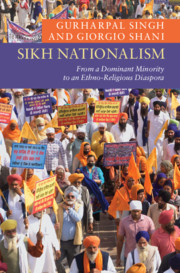Book contents
- Sikh Nationalism
- New Approaches to Asian History
- Sikh Nationalism
- Copyright page
- Contents
- Maps
- Figures
- Tables
- Acknowledgements
- Abbreviations
- Glossary
- Introduction
- 1 Understanding Sikh Nationalism
- 2 Sikhism and the Sikhs up to the 1890s
- 3 The Emergence of Modern Sikh Nationalism, 1880s–1930s
- 4 The Partition of India and the Sikhs, 1940–1947
- 5 The Indian Union and the Sikhs, 1947–1984
- 6 Militancy, Antiterrorism and the Khalistan Movement, 1984–1997
- 7 Sikh Nationalism in the Age of Globalisation and Hindutva, 1997 to the Present
- 8 The Diaspora
- Conclusion
- Timeline
- Appendix: Anandpur Sahib Resolution
- References
- Index
- New Approaches to Asian History
7 - Sikh Nationalism in the Age of Globalisation and Hindutva, 1997 to the Present
Published online by Cambridge University Press: 19 November 2021
- Sikh Nationalism
- New Approaches to Asian History
- Sikh Nationalism
- Copyright page
- Contents
- Maps
- Figures
- Tables
- Acknowledgements
- Abbreviations
- Glossary
- Introduction
- 1 Understanding Sikh Nationalism
- 2 Sikhism and the Sikhs up to the 1890s
- 3 The Emergence of Modern Sikh Nationalism, 1880s–1930s
- 4 The Partition of India and the Sikhs, 1940–1947
- 5 The Indian Union and the Sikhs, 1947–1984
- 6 Militancy, Antiterrorism and the Khalistan Movement, 1984–1997
- 7 Sikh Nationalism in the Age of Globalisation and Hindutva, 1997 to the Present
- 8 The Diaspora
- Conclusion
- Timeline
- Appendix: Anandpur Sahib Resolution
- References
- Index
- New Approaches to Asian History
Summary
This chapter examines how economic liberalisation and globalisation in India are reframing Sikh nationalism. This is explored by an analysis of Sikh political elites’ record in promoting inclusive regionalism while managing dissent within the ‘Sikh political system’. Such governance has struggled to deliver either rapid economic development or a new social contract between Sikh values and India’s political system; and, paradoxically, while the dominant narrative of Sikh nationalism has become more accommodating of a future within Indian statehood, and of social and political diversity within itself, the rise of Hindu nationalism makes the Sikhs vulnerable to pressures of greater cultural and religious assimilation. We assess the likely consequences of the new phase of ‘hegemonic control’ post-militancy, the impact of social and cultural changes as result of economic liberalisation and globalisation, and how assertive Hindu nationalism poses a major challenge to a separate Sikh identity in contemporary India.
- Type
- Chapter
- Information
- Sikh Nationalism , pp. 163 - 188Publisher: Cambridge University PressPrint publication year: 2021

